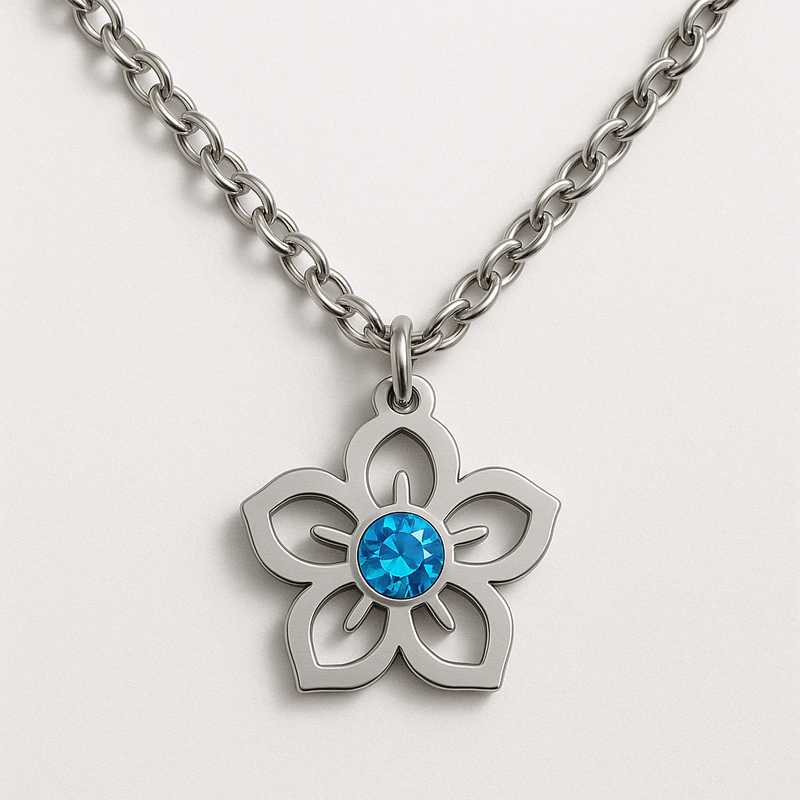Engineered Elegance: Material Science in Charm Necklace Design

Subtitle: Dive into stainless steel grades, precision tech, and eco-friendly methods shaping OEM/ODM birthstone jewelry manufacturing.
Introduction: The Fusion of Material Science and Design
The art of crafting birthstone charm necklaces has evolved into a highly technical process, where material science meets intricate design. In the fast-growing field of OEM/ODM jewelry manufacturing, the selection of materials such as stainless steel plays a pivotal role in ensuring both the aesthetic appeal and long-term durability of these custom pieces. Among the various grades of stainless steel available, 304 and 316L stand out as the leading choices for manufacturers aiming to balance both corrosion resistance and flexibility in design. Additionally, the adoption of cutting-edge technologies such as laser cutting and environmentally conscious processes like green electroplating are transforming the jewelry industry. This article explores the role of these materials and manufacturing technologies in the creation of exquisite, eco-friendly, and durable birthstone charm necklaces.
Understanding Stainless Steel Grades: 304 vs 316L
When designing custom birthstone charm necklaces, selecting the right stainless steel grade is crucial. Two of the most commonly used grades are 304 and 316L, each offering unique benefits depending on the intended application and environmental conditions.
304 Stainless Steel: A Standard Choice for Durability
304 stainless steel is the most widely used stainless steel alloy, known for its excellent balance between cost-effectiveness, corrosion resistance, and workability. Composed primarily of iron, chromium, and nickel, 304 steel is commonly used in a variety of applications, including jewelry. It’s particularly valued for its ability to withstand everyday wear and tear in dry environments. However, its resistance to corrosion can be compromised when exposed to harsher conditions, such as saltwater.
316L Stainless Steel: The Premium Grade for Tougher Conditions
On the other hand, 316L stainless steel is an upgraded version of 304, with added molybdenum that enhances its resistance to corrosion, especially in marine environments or areas with high salinity. This makes it an ideal choice for jewelry manufacturers seeking to produce pieces that are durable under more extreme conditions, such as coastal areas or high-humidity environments. For birthstone charm necklaces, 316L provides a longer-lasting solution, ensuring that the pieces retain their appearance and integrity over time. Its superior corrosion resistance also reduces the risk of tarnishing and discoloration, which is a crucial factor for high-end, custom designs.
Corrosion Resistance Comparison and Application Scenarios
- 304 Stainless Steel: Suitable for dry, low-humidity environments, typically used in mass-market jewelry products.
- 316L Stainless Steel: Ideal for harsher environments, including coastal areas or for customers looking for high-performance, long-lasting jewelry.
Precision Manufacturing: Laser Cutting and Hydraulic Processes
Modern jewelry manufacturing has embraced advanced technologies like laser cutting and hydraulic processes to create intricate designs with precision. These technologies allow manufacturers to achieve a level of detail and accuracy that was previously impossible with traditional methods.
Laser Cutting: Precision and Versatility
Laser cutting is one of the most popular technologies used in custom jewelry design. With the ability to cut intricate patterns and designs into stainless steel with micron-level precision, laser cutting allows for the creation of highly detailed birthstone charm necklaces. Laser cutting also minimizes material waste, making it an environmentally friendly choice. The ability to cut through stainless steel without affecting the integrity of the material means that delicate designs and fine details can be realized without compromising strength.
Hydraulic Pressing: Shaping Metal with Power
Hydraulic pressing is another key manufacturing technology in jewelry production. By using high-pressure hydraulic systems, manufacturers can mold stainless steel into the desired shape with great accuracy. This method is especially useful for creating complex geometric shapes or large, bulkier components of a necklace. The advantage of hydraulic pressing lies in its ability to work with thicker stainless steel components, which may not be as easily manipulated with other techniques like stamping.
Eco-Friendly Manufacturing: Sustainability in the Jewelry Industry
As sustainability becomes increasingly important in all industries, the jewelry sector is also making significant strides in reducing its environmental impact. From waste recycling to green electroplating, manufacturers are adopting processes that minimize waste and use less harmful chemicals in production. These green manufacturing practices align with consumer demand for environmentally conscious products and add value to brands that prioritize eco-friendly solutions.
Recycling and Waste Reduction in Jewelry Production
Recycling has become a key practice in stainless steel jewelry manufacturing, especially as precious metals and other materials become scarcer. By reclaiming metal scraps and reusing them in new pieces, manufacturers reduce the need for raw materials and lower the overall environmental impact of their production processes. This practice not only benefits the planet but also helps manufacturers keep costs down, making it a win-win for both business and the environment.
Green Electroplating: A Sustainable Finish
Traditional electroplating processes often rely on toxic chemicals that can be harmful to both the environment and the people involved in the production. However, green electroplating technology offers an environmentally friendly alternative. By using non-toxic, eco-friendly chemicals, this method reduces pollution and ensures that the finished product meets high-quality standards without compromising environmental safety. For birthstone charm necklaces, green electroplating provides a way to achieve brilliant, durable finishes while adhering to eco-friendly principles.
Conclusion: Crafting the Future of Sustainable, Custom Jewelry
In conclusion, the combination of superior materials, cutting-edge technologies, and sustainable practices is shaping the future of custom birthstone charm necklaces. Whether using the corrosion-resistant properties of 316L stainless steel or the precision of laser cutting, manufacturers are creating pieces that not only stand the test of time but also align with modern environmental values. By incorporating green technologies such as eco-friendly electroplating and waste recycling, businesses can offer high-quality, sustainable products that appeal to today’s conscious consumer. For OEM/ODM jewelry manufacturers, staying at the forefront of these material science advancements and production techniques will ensure that their designs remain both innovative and responsible.
Ready to create custom birthstone charm necklaces with cutting-edge materials and eco-friendly processes? Contact us today to explore our OEM/ODM manufacturing services!
